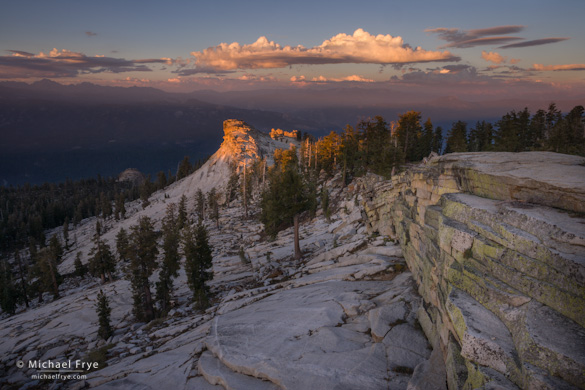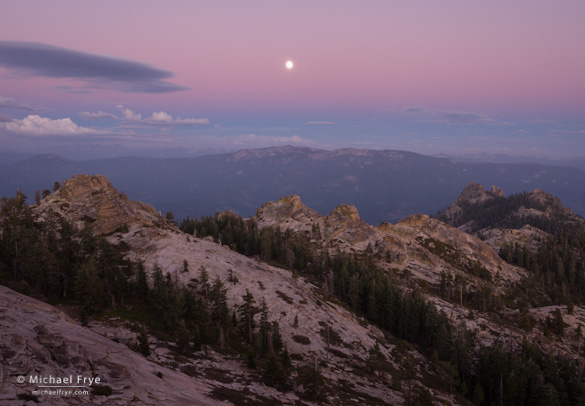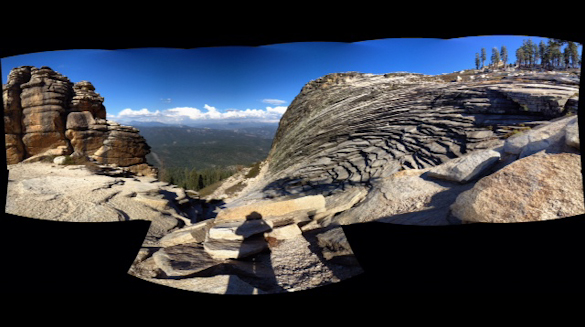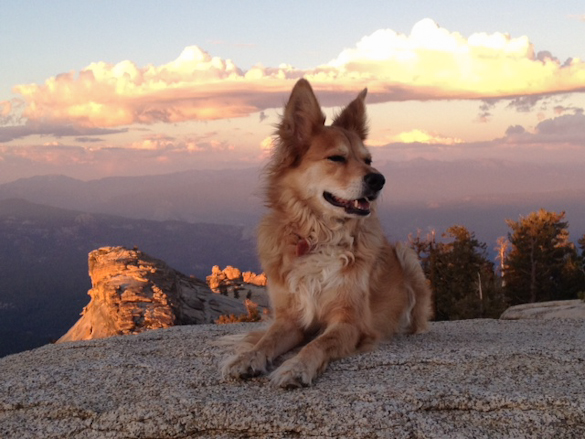The Journey to Shuteye Peak
Last Thursday my wife Claudia and I—and our dog Rider—went to Shuteye Peak to photograph the moonrise. (Well Claudia and I went for the moonrise—Rider went to look for squirrels.)
Shuteye Peak is in the Sierra National Forest south of Yosemite, and from the fire lookout on top (8,351 feet) you can see a spectacular 360-degree view that includes the Clark Range, Mt. Lyell (both in Yosemite), Mount Ritter, the Minarets, Mammoth Mountain, Bear Creek Spire, the Kaiser Wilderness, and the deep gorge of the San Joaquin River 5000 feet below.
I had been to Shuteye Peak many years ago on a scouting trip. I didn’t take any photos, but remembered the amazing view and wanted to go back. Claudia and her friend Anne had tried hiking there last year, but hadn’t managed to navigate the maze of Forest Service roads approaching the mountain.
There’s a road to the summit of Shuteye Peak, and supposedly in the past you could drive a station wagon up it. Not any more. The road has deteriorated, to say the least, and now the last two-and-a-half miles from Little Shuteye Pass are a very difficult and rocky four-wheel-drive trail, suitable only for expert drivers in appropriate vehicles. We found the route to Little Shuteye Pass (even that road requires a high-clearance vehicle), but hiked that last stretch.
When we reached the tower at the summit we met Ray, the Forest Service lookout. Ray was super nice, giving us a guided tour of all the landmarks visible from the tower, and offering us sodas and snacks. Then Claudia mentioned to me that her iPhone battery was down to 17 percent, so she wasn’t sure she’d be able to take any photos of the moonrise. Ray overheard this, and said that he happened to have two iPhone chargers! So Claudia was able to recharge her phone and get her camera up and running. The tower has solar power and satellite TV, and Ray has internet access through his iPhone and a cell booster.
As the sun got lower I started scouting for photo locations. There were some clouds over the Sierra crest, plus twisted trees and layered rock formations that could make good foregrounds—though none of these objects seemed to line up well with where I expected the moon to rise. As I looked for foregrounds Rider followed me, looking for squirrels.
When the sun sunk further I started taking photographs. Soon the moon appeared, and I captured a few frames of it, but I was more attracted to a thumb of rock on a ridge below the summit that was catching the last rays of sunlight. I eventually found a spot where I could use the curving, layered strata of the ridge as a foreground leading to that thumb (the image at the top of this post). Then I ran (literally, sometimes) to another angle where the thumb lined up better with the clouds, getting there just before the light left the thumb. But, as it turned out, I didn’t like that angle as much.
Climbing back to the ridge I found a composition with some rock formations and diagonal lines in the foreground, and the moon overhead (below).
The Trouble With High Places
But although these photographs turned out okay, I wasn’t thrilled with them. My first handicap was the unfamiliar location. It’s difficult to make great images in a place you’ve never photographed before. Sometimes it happens—you just get lucky and happen to be in the right spot at the right time. But that’s the exception. More often you see that the light is great over there, but by the time you get there it’s too late. If I had known, for example, about the last light hitting that thumb of rock I would have scouted locations with that in mind. I might have even hiked out to it. Next time.
The other problem was that high viewpoints rarely make good photo locations. This seems counterintuitive, because standing on a high summit—especially one with a sweeping, panoramic, world-class view like Shuteye Peak—is a breathtaking experience. But that euphoria is created by the unfamiliar sensation of being high up and having such vast space around you, not necessarily by the actual visual components of the scene. On Shuteye, for example, the distant peaks of the Sierra crest amounted—visually—to no more than a thin strip of bumps on the horizon. Photographically, looking up at a mountain usually works better than looking down from it.
I’m not suggesting that you avoid these high viewpoints. Life is about more than photography, and visiting these summits is a great experience. Even though I didn’t come home with fantastic images, we had a wonderful time, and a big adventure, on our hike to Shuteye Peak. I knew that the high and unfamiliar viewpoint would make photography challenging, so my expectations were low.
If you want to try making photographs from such a spot anyway, here are a couple of suggestions. First, don’t try to include the whole panorama; everything will just look small, distant, and uninteresting. Use a telephoto lens, pick out an interesting detail, and zoom in on it. While I didn’t find this kind of telephoto composition on Shuteye Peak, from a high vantage point on Yosemite’s Pothole Dome this summer I zoomed in on distant peaks and spectacular cloud formations (see the fourth and fifth photographs in this post).
Second, try to find an interesting foreground. Juxtaposing a foreground with the distant view can help convey the sense of space and distance that you feel in high places. That’s what I tried to do with that thumb of rock on Shuteye Peak.
As we hiked back in the dark the moon helped light our way, and Claudia and I saw occasional flashes of lightning 30 miles away to the east. By the time we reached our vehicle, drove ten miles of dirt roads, then some winding paved roads, stopped at Jack in the Box in Oakhurst, and reached home, it was 11:30. We had a great time, and we’ll be back.
—Michael Frye
Related Posts: Hidden Yosemite Workshop
Michael Frye is a professional photographer specializing in landscapes and nature. He is the author and photographer of The Photographer’s Guide to Yosemite, Yosemite Meditations, and Digital Landscape Photography: In the Footsteps of Ansel Adams and the Great Masters, plus the eBooks Light & Land: Landscapes in the Digital Darkroom, and Exposure for Outdoor Photography. He has written numerous magazine articles on the art and technique of photography, and his images have been published in over thirty countries around the world. Michael has lived either in or near Yosemite National Park since 1983, currently residing just outside the park in Mariposa, California.














Michael,
I totally agree that wide angle landscapes photographed from high places leave a lot to be desired although your images are excellent! Certain 360 degee panoramics might be an exception but usually things in the distance get relegated to just a few pixels on the sensor making them, as you pointed out, uninteresting. What sometimes works when one is up quite high is zooming in on clouds that are considerably lower than where one is standing. This is not uncommon on some of the higher peaks in the rockies. Also, low angle shots above timberline that includes some alpine tundra or an alpine lake in the foreground can render nice photographs using wide angle lenses.
Thanks James – I appreciate your comments. I hadn’t thought about looking down on clouds from high places, but that certainly can happen and could look great if you’re lucky enough to find it.
I enjoyed your narrative of challenges in this new location. You’re leading by example and exploring unfamiliar territory sends the right message, in my opinion, as do your descriptions of challenges that even a pro like you experiences. This is more encouraging than always showing spectacular iconic perfection. Regardless, I like how the photo posted here turned out. By not blaring at full volume, it allows the viewer the chance for it to grow on him or her.
Thanks David! I agree that it’s sometimes good to show the struggles as well as the successes, and I’m glad you like the photo.
Nice dog, Michael!;)
Looks like a cool location…I always thought that´s just an issue with me when scouting/finding a new location and being a bit behind the light/angle/composition (and overwhelmed by the new impressions). Thanks for your insight and showing those images….
Werner
Rider says thanks Werner! 🙂 She is quite photogenic if I say so myself. Photographing a new location is a challenge, but rewarding too – though sometimes you have to make another trip to really take advantage of what you learned the first time.
Great advice as usual, Michael. Your blog is a joy to read. Thank you.
Thanks Ian!
Great advise as usual Michael. Being from a career that took me to many mountain tops to work at, I totally understand what you are talking about. I wish I was into Photography then as I had many odd hour and weather trips that would have made for some nice photographs. It is beautiful just being there as you say. I have a good story to tell you when I see you next month about a Forest Ranger I met. Until then take care keep and up the excellent work!
Thank you Marc – and I look forward to hearing your ranger story. 🙂
Michael:
So true. I love ascending peaks for the challenge and experience of the climb and for the exhilaration of being on the summit, especially when accompanied by a group of good friends. But photographing from there? Not so much. For all the reasons you mention, and more. The mountain may well be the subject of a wonderful photograph, but it is darned hard to see it when you are standing on it!
There are, of course, exceptions. One that immediately comes to mind is Keith Walklet’s lovely and stunning photograph up a section of the Tuolumne River from Wildcat Peak, showing cascades and whitewater, beautiful light, the Sierra terrain leading to the crest.
(Sounds like we might occupy _slightly_ different points the line between “I only like photographing new things” and “I photograph the same things over and over.” I do photograph the same things over and over, and love the experience of learning to more fully understand and see them – but I also love shooting new subjects, perhaps as _my_ way of learning about them, too.)
Dan
Dan, I know the image of Keith’s that you’re referring to, and it’s a great one. I think one of the differences in that case is that he wasn’t too high, so the perspective on the river and terrain below wasn’t too distant. William Neill also has a wonderful image from the top of Mount Hoffman, a telephoto view but with a ridge and another peak in the foreground to add depth. It’s on the fourth page here:
http://www.williamneill.com/portfolios/yosemite/index.html
So great images can be made from high places, but it’s challenging, and I think it requires the right circumstances.
I like photographing new things too, but I don’t expect to come home with great images from a location I’ve never been to before unless I have several days to get familiar with the place. Sometimes, as I said, you get lucky. And if the location doesn’t require special light or clouds or other conditions – more typical of intimate scenes than big landscapes – then it’s certainly possible to arrive and find a great composition within an hour or two.
Experience helps also. I think an experienced photographer can assess the possibilities more quickly and accurately than a less-experienced photographer and take an educated guess about where to go and what to look for.
I find it quite funny that whenever I find unusual image, making me want to comment and say how much I enjoyed viewing it on your blog, it is an image taken by your wife ;). Last time it was tree shadows from the eclipse, this time- image of Rider with beautiful sunset in the background.
Iza – Hah! Claudia will be happy to hear that – and Rider too.
I’m very happy to hear that 🙂 Iza, thank you!
Michael, I’ve been to the top of Shuteye Peak many times, but not recently…have been thinking about going up there to take a few photos….but after reading your blog and seeing your images which I find beautiful…I think I’ll leave my camera home….! Jeep yes, camera no! It’s a great lookout….
Robin
Well Robin, maybe you just take the camera along just in case… 🙂
Hi Michael,
Great post.
I really love the photo that Claudia took of Rider!
One bit of info that I would like to share regarding cell phones, iPhones, iPads.
Always turn off the roaming on these devices, when you are in areas with weak cellsignals.
The roaming setting will constantly search for a signal, which will rapidly drain your battery.
Having said that … I was on a shoot at the Tule Elk Preserve in Pt. Reyes on Labor Day.
I forgot to turn off the roaming on my phone.
After filming and hiking (7 miles round trip) for 6 hrs, I got to my rental car and had 0 battery strength left.
Had to drive back to San Francisco in extremely foggy weather with no cell phone 🙁
Lesson learned. 🙂
Paolo
Smoky Cat Productions
Jacksonville, FL
Thank you Paolo. That is exactly what happened. Luckily, Ray was kind enough to allow me to charge my phone at the lookout and I was able to take more photos. Rider was so tired from running all over the peak that she was quite willing to settle on the rock for a minute to rest. It would have been a shame had I missed the opportunity. Lesson learned indeed! 🙂
Awww, Rider is adorable! What a lovely shot, Claudia. I love reading about your journeys, Michael. The last light on that thumb of rock is beautiful.
You are so right about photographing new places. It’s a much about learning about the new place as it is being somewhat fortunate in having good conditions.
Claudia and Rider say thanks Vivienne! 🙂
You know, the more I look at your first image (“last light on a granite thumb”), the more I like it. I especially like the exfoliation leaves that lead in from the right and take your eye to the lit thumb. Unable to resist a suggestion, though: how about a squarish crop? Lose the left 20% or so? I think you’ve made a better image than you credit yourself for 🙂
Thanks Eric. I’ll think about your cropping suggestion. I actually originally composed this with less room on the left side, then tried the composition you see here, and ended up liking this better. As your suggestion implies, there is some “dead” space on the left side that’s not adding much to the photo. On the other hand the foreground rock layers point to the thumb, which also points left, so I wanted to leave some space to the left of the thumb for viewers to see the distant peaks that thumb is pointing too (this makes a bit more sense when you see this image larger). In other words, since the eye movement here is from lower-right to upper left, I didn’t want to cut off that flow prematurely.
I think these are the reasons I’m not completely satisfied with this photograph. The gesture of the thumb points left, leading the eye out of the frame, and also in order to include the layers of rock in the lower-right I had to include some not-very-interesting stuff in the lower-left. It didn’t all fit together as completely as I would wish.
Thanks for the thoughts, Michael. I understand your reservations much better from your explanation.
While I know what you mean about the challenges with capturing images in these kinds of high places, how can you still not love them? If the image itself isn’t visually stunning enough, the way it brings you into this spectacular spot still comes through. The first image of the last light on the granite thumb is wonderful. I don’t think it suffers at all from the perspective. Top honor for the evening goes to Claudia though, for the portrait of Rider at the end. Sorry, I’ve just got a huge soft spot for trail dogs. :). Thanks for the journey to another magical spot.
Mark
Thanks for your comments Mark. Claudia’s photo of Rider seems to be quite popular! 🙂
That’s a clever answer to a tricky qeuitson
Michael,
Completely enjoyed your blog entry and agree with the difficulties you identified. Adding the foreground element helps a lot. Sometimes I find cropping to a pano view works nicely too. As always, thanks for sharing your knowledge. Best Regards.
Thank you Michael! A panorama is another good option – it eliminates less-inretesting stuff above and below the horizon.
Michael,
Your photographs are incredible. Do you print in house? If not, who do you use or who do recommend for gallery quality printing.
Thank you Mark. Yes, I have my own large printer, so I do all my own printing. West Coast Imaging or their sister company Aspen Creek Photo offer very high quality printing services.